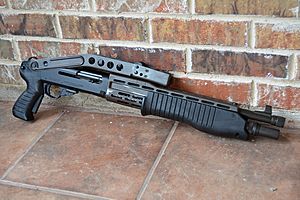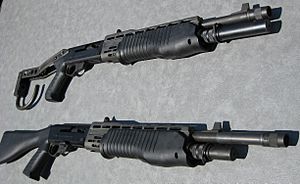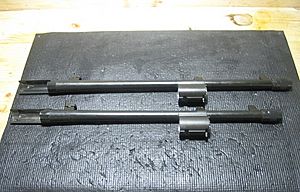Franchi SPAS-12 facts for kids
Quick facts for kids Franchi SPAS-12 |
|
|---|---|

SPAS-12 with short barrel
|
|
| Type | Special shotgun |
| Place of origin | Italy |
| Service history | |
| In service | 1979–present |
| Used by | See Users |
| Wars | The Troubles Lebanese Civil War |
| Production history | |
| Designer | Franchi |
| Designed | 1979 |
| Manufacturer | Franchi |
| Produced | 1979–2000 |
| No. built | 37,000 |
| Variants |
|
| Specifications | |
| Mass |
|
| Length |
|
| Barrel length |
|
|
|
|
| Cartridge | 12 gauge 23⁄4 inch shells only |
| Action | Pump-action/gas-operated |
| Rate of fire | Semi-automatic or pump action |
| Effective firing range | Dependent on ammunition used |
| Feed system | Tube Extension 5+1, 6+1, 7+1 and 8+1 rounds, internal tube magazine |
| Sights | Iron sights |
The Franchi SPAS-12 is a special shotgun made by the Italian company Franchi. It was produced from 1979 to 2000. This shotgun is unique because it can work in two ways: semi-automatic or pump-action mode.
In semi-automatic mode, the shotgun reloads itself after each shot. In pump-action mode, the user must manually move a part of the gun to load the next shell. The SPAS-12 was sold to military and police groups around the world. It was also available to regular people. You might have seen it in many films, TV shows, and video games.
The SPAS-12 was first called the Special Purpose Automatic Shotgun. It was built to be a strong and reliable shotgun for military use. Later, in 1990, Franchi changed its name to Sporting Purpose Automatic Shotgun. This change helped them continue selling it in the United States. However, sales stopped in 1994 due to a law called the Federal Assault Weapons Ban. Even though the ban ended in 2004, Franchi had already stopped making the SPAS-12 in 2000. They decided to focus on making a newer model called the SPAS-15.
Contents
How the SPAS-12 Works
The SPAS-12 was mainly designed to work in semi-automatic mode. The pump-action mode was used for special types of ammunition. This included things like tear gas rounds or less-harmful bean bags. You can switch between these modes by pressing a button under the front grip. Then, you slide the grip forward or backward until it clicks. This opens or closes gas ports inside the gun.
In semi-automatic mode, the gun uses a gas system to reload. When a shell is fired, gas from the shot pushes a part called a piston. This piston then helps move other parts to eject the empty shell and load a new one.
The SPAS-12 also has a special feature called a magazine cut-off. This stops new rounds from coming out of the magazine when you reload. This allows the user to load a different type of shell into the gun without having to unload the one already in the chamber.
Special Features and Parts
Some versions of the SPAS-12 have a folding stock with a unique hook. When the stock is open, this hook can be turned to fit under your forearm. This design helps you fire the shotgun with one hand. This could be useful if you are climbing down a rope or shooting from a vehicle. The hook can also be removed completely.
The SPAS-12 models have two safety features. One is a lever or push-button safety. The other is a "quick employment safety." This second safety is on the left side of the trigger guard. It disconnects the trigger when it's on. You can turn it off quickly with your trigger finger when you are ready to shoot. This is helpful for fast-paced situations.
The barrel of the SPAS-12 was made to attach different accessories. It was designed to spread a normal shot over a wide area.
There are four main types of magazine extension tubes for the SPAS-12:
- A 5-shell tube for the 18-inch barrel.
- A 6-shell tube for the standard 21.5-inch model.
- A 7-shell tube for the 19 7/8-inch barrel.
- An 8-shell tube for the 21.5-inch special purpose model.
Many different types of chokes (parts that control how wide the shot spreads) were available. Some early SPAS-12 models even came with a special shot diverter. This part could spread the shot either vertically or horizontally.
SPAS-12, SAS-12, and LAW-12 Differences
The SPAS-12 came with four different stock styles. Early models had a wooden stock. Later ones featured the folding metal stock with a hook. After import rules changed in the U.S. in 1989, a version with a fixed plastic stock and a six-shell capacity was made. This was to follow new rules for "sporting" firearms.
There were also four different factory barrel lengths for the SPAS-12:
- A very rare 18-inch "shorty" barrel, mostly for police and military.
- A very rare 19 7/8-inch barrel, also for police and military.
- A 21 1/2-inch barrel, often made longer for legal reasons in the United Kingdom.
- The most common 21 1/2-inch barrel, used for both special purpose and sporting models.
The SPAS-12 had simple sights: a round hole at the back and a large blade at the front.
Sister Shotguns: LAW-12 and SAS-12
The SPAS-12 had two "sister" shotguns: the LAW-12 and the SAS-12. These models could use many of the same parts as the SPAS-12, like trigger groups and stocks. However, their magazine extension tubes were not meant to be swapped with the SPAS-12.
The Franchi SAS-12 was a pump-action-only shotgun. It could use larger 3-inch shells. It had a 21.5-inch barrel and could hold 8 rounds in the magazine plus 1 in the chamber.
The Franchi LAW-12 was a semi-automatic-only shotgun. It was also affected by import bans in the U.S. The LAW-12 was lighter than the SPAS-12. It was often sold to police departments as a cheaper option. The LAW-12 also had a 21.5-inch barrel and could hold 8 rounds in the magazine plus 1 in the chamber. Franchi stopped making the LAW-12 shortly before the SPAS-12 was discontinued in 2000.
SPAS-12 in the United States
Importers
Two companies brought the SPAS-12 into the United States. The first was F.I.E. Corp, from 1982 to 1989. Their sales dropped a lot when the U.S. government changed rules about importing firearms. These rules said guns had to have a "sporting purpose" to be imported.
In 1990, American Arms Inc. bought the remaining parts and shotguns from F.I.E. Corp. They started importing the SPAS-12 again, calling it the "Sporting Purpose Automatic Shotgun." This was allowed under new rules until 1994. The U.S. Coast Guard even tested the SPAS-12 and liked it. However, they found other suppliers to be more affordable.
The Federal Assault Weapons Ban in September 1994 stopped American Arms from importing the SPAS-12. This caused big losses for the company. Both importers had ordered many more SPAS-12s than they could bring in. This is why only a small number of these shotguns were imported into the United States.
Legality
In the United States, a law called the Federal Assault Weapons Ban was in place from September 1994 to September 2004. This law made it illegal to buy or own SPAS-12 shotguns made after September 13, 1994. When the ban ended in 2004, it became legal again in most places. However, some U.S. states and areas still have similar bans. These include California, Connecticut, Maryland, Massachusetts, New Jersey, and New York.
Users Around the World
The SPAS-12 shotgun has been used by various military and police forces globally:
 Argentina: Used by a special operations unit called Brigada Especial Operativa Halcón.
Argentina: Used by a special operations unit called Brigada Especial Operativa Halcón. Austria: Used by EKO Cobra, a special police unit.
Austria: Used by EKO Cobra, a special police unit. Brazil: Used by the Grupo de Ações Táticas Especiais (GATE).
Brazil: Used by the Grupo de Ações Táticas Especiais (GATE). Chile: Used by the Chilean Gendarmerie.
Chile: Used by the Chilean Gendarmerie. France: Used by GIGN, a special intervention unit.
France: Used by GIGN, a special intervention unit. Indonesia: Used by Kopaska (tactical group) and Kopassus (special-forces group).
Indonesia: Used by Kopaska (tactical group) and Kopassus (special-forces group). Ireland: Used by the Army Ranger Wing.
Ireland: Used by the Army Ranger Wing. Lebanon: Used by police forces.
Lebanon: Used by police forces. Malaysia: Used by the National Special Operations Force.
Malaysia: Used by the National Special Operations Force. Portugal: Used by the Portuguese Armed Forces.
Portugal: Used by the Portuguese Armed Forces. Taiwan
Taiwan Turkey: Used by the Turkish Gendarmerie.
Turkey: Used by the Turkish Gendarmerie. United States: Used by police SWAT teams.
United States: Used by police SWAT teams.
Non-State Users
 Lebanese Forces
Lebanese Forces Provisional Irish Republican Army
Provisional Irish Republican Army
See also
 In Spanish: SPAS-12 para niños
In Spanish: SPAS-12 para niños
- Benelli M4
- List of shotguns






